Laws of Motion | Physics - Long Questions and Answer | 11th Physics : UNIT 3 : Laws of Motion
Chapter: 11th Physics : UNIT 3 : Laws of Motion
Long Questions and Answer
Laws of Motion | Physics
Long Answer Questions
1. Prove the law of conservation of linear momentum. Use it to find the recoil velocity of a gun when a bullet is fired from it.
●
When
two particles interact with each other, they exert equal and opposite forces on
each other. The particle 1 exerts force ![]() on particle 2 and particle 2
exerts an exactly equal and opposite force
on particle 2 and particle 2
exerts an exactly equal and opposite force ![]() on particle 1.
on particle 1.
●
According
to Newton's third law.
 ………..(1)
………..(1)
●
In
terms of momentum of particles, the force on each particle (Newton's II law)
can be written as
 ………(2)
………(2)
● Here ![]() is the momentum of particle 1 which change due to Force
is the momentum of particle 1 which change due to Force ![]() exerted by particle 2 and
exerted by particle 2 and ![]() is the momentum of particle 2.
is the momentum of particle 2.
● This changes due to ![]() exerted
by particle
exerted
by particle
1.
Substitute equation 2 in equation 1.
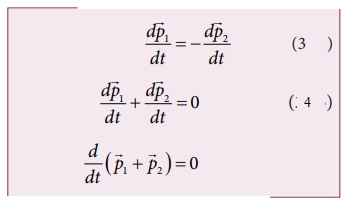
●
It implies that ![]() +
+ ![]() = constant vector
= constant vector ![]() +
+ ![]() is
the total
is
the total
●
linear momentum of the two particles (![]() =
=![]() +
+![]() )
)
●
It is also called as total linear momentum of the system.
●
"If there are no enternal forces acting on the system, then the total
linear momentum of the system (![]() ). is always a constant
vector".
). is always a constant
vector".
●
The total linear momentum of the system is conserved in time.
Rewil
velocity of a gun when bullet is fired from it:
●
Let 'M' be the mass of gun and m be, the mass of the bullet.
●
Initially both the gun and bullet are at rest on firing the gun,
●
Suppose the bullet moves with velocity V and the gun moves with velocity v.
According to the principle of conservation of momentum,
●
Total momentum of gun and bullet before firing = Total momentum of gun and
bullet after firing.
(ie)  (Total momentum before firing is zero because of both are in
rest)
(Total momentum before firing is zero because of both are in
rest)

●
The negative sign shows that  are in opposite direction (ie) as
the bullet moves forward, the gun will move in backward direction. The backward
motion of the gun is called recoil of the gun and this velocity is recoil
velocity.
are in opposite direction (ie) as
the bullet moves forward, the gun will move in backward direction. The backward
motion of the gun is called recoil of the gun and this velocity is recoil
velocity.
2. What are concurrent forces? State Lami’s theorem.
Concurrent
forces:
●
A collection of forces is said to be concurrent, it the line of forces act at a
common point.
●
Cocurrent forces not be in the same plane. If they are in the same plane, they
are concurrent as well as coplanar forces.
Lami's
Theorem:
●
If the system of three concurrent and coplanar forces are in equilibrium,
Lami's theorem states that the magnitude of each force of the system is
proportional to sine of the angle between other two forces. The constant of
proportionality is same for all three forces.
●
Consider three coplanar and concurrent forces,  which act at
a common point.
which act at
a common point.
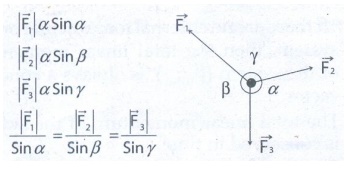
●
Lami's theorem is useful to analyse the forces acting on objects which are in
static equilibrium
3. Explain the motion of blocks connected by a string in i) Vertical motion ii) Horizontal motion.
i)
Vertical motion:
●
Consider two blocks of masses m1 and m2 (m1
> m2) connected by a light and in extensible string that passes
over a pulley as shown in figure.
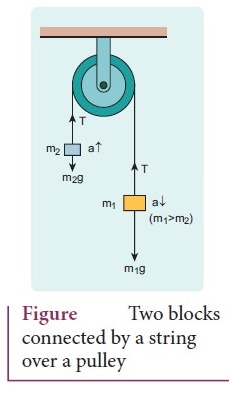
●
Let the tension in the string be T and acceleration a.
●
When the system is released, both the blocks start moving, m2
vertically upward and m2 downward with same acceleration
a.
The gravitational force m1 g on mass m1 is used in
lifting the mass m2.
●
The upward direction is chosen as Y direction
Free
body diagram shown in figure
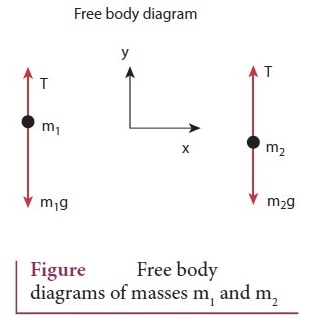
●
Applying Newton’s second law for mass m2,

●
By comparing the components on both sides
we
get, T − m2g = m2a ………….(1)
Similarly for mass m1
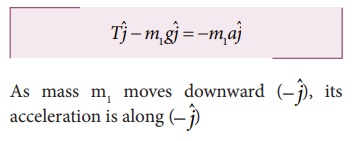
●
By comparing the component on both sides we get m1g - T = m1a ………… (2)
●
Adding equation (1) and (2)
we
get (m1 - m2) g = (m1 + m2)a ………. (3)
●
From the equation (3), the acceleration of both the masses is
a
=
(m1−m2 / m1+m2)g ……….. (4)
●
If both the masses are equal (m1 − m2) from equation (4)
a = 0
●
Tension on the string can be obtained by substituting the acceleration from the
eqn. (4) in to eqn (1)
T = m2g + m2(m1−m2
/ m1+m2)g ……….. (5)
●
By taking m2 g common in the RHS of eqn (5) we get
T
= (
2m1m2 / m1+m2 )g
●
Equation (4) gives only magnitude of acceleration for mass m1, the
acceleration vector is
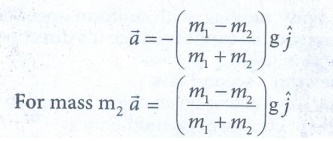
ii)
Horizontal motion:
In
this case, mass m2 is kept on a horizontal table and mass m1
is hanging through a small pulley.
The
forces acting on a mass m2, and m1 are shown in free body
diagram
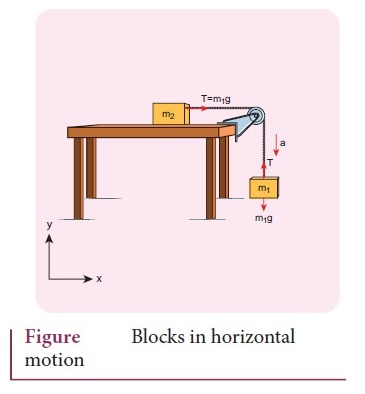
Applying
Newton's second law for m1
 (along y direction)
(along y direction)
By
comparing the components on both side,
T
– m1g = -m1a …………… (6)
Similarly
for m2
 (along x direction)
(along x direction)
By
comparing the components on both side,
T
− m2a ………… (7)
There
is no acceleration along Y direction for m2

N
- m2g = 0
(ie)
N = m2g …………… (8)
Substituting
equation (7) in eqn. (6), we get
a
= ( m1 / [m1+m2]
) g …………… (9)
Substituting
equation (9) in equation (7) we get, Tension in the string
T
= ( m1m2 / [m1+m2] ) g …………… (10)
Comparing
motion in both cases, it is clear that the tension in the string for horizontal
motion is half of the tension for vertical motion for same set of masses and
strings.

4. Briefly explain the origin of friction. Show that in an inclined plane, angle of friction is equal to angle of repose.
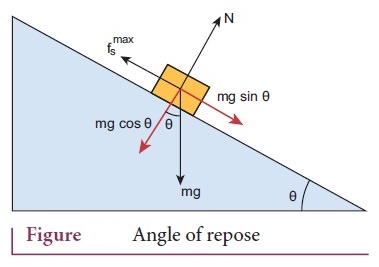
●
The force of friction is due to the atomic or molecular forces of attraction
between the two surfaces at the points of actual contacts.
●
Due to the surface irregularities, the actual area of contact is much smaller
than the apparent area of contact.
●
The pressure at the point of contact is very large, molecular bonds are formed
at these points.
●
When one body is pulled over the other, the bonds breaks, the material is
deformed and new bond are formed.
●
The local determation sends vibration waves into the bodies. These vibrations
finally damp out and energy appears as heat. Hence a force is needed to start
or maintain the motion.
Angle
of friction is equal to angle of repose:
●
Consider an inclined plane on which an object is placed.
●
Let the angle which this plane make with the horizontal be θ.
●
As θ is increased for a particular value of θ the object begins slide down.
This value is called angle of repose.
●
The component of force perpendicular to the inclined plane (mg cosθ) is
balanced by the normal force (N)
(ie.)
N = mg cosθ ………… (1)
●
When the object just begins to move, the static friction affairs its maximum
value
ƒs = ƒsmax = μsN
= μs mgcosθ ……….. (2)
●
This friction also satisfies the relation
ƒsmax
= mg sinθ …………….
(3)
dividing
eqn. (2 and 1) ƒsmax
ƒsmax
/ N= sinθ / cosθ = tanθ
μs
= sinθ / cosθ
μs
= tanθ …………….
(4)
●
From the definition θ is angle of friction. States that the co efficient of
static friction is equal to tangent of the angle of friction.
●
Thus the angle of repose is the same as angle of friction.
5. State Newton’s three laws and discuss their significance.
Newton's
first law:
Every
object continues to be in the state of rest (or) of uniform motion (constant
velocity) unless there is external force acting on it.
●
A body at rest continues in its state of rest.
●
A body in motion continues moving in a straight line with a uniform speed.
●
A body moving with uniform speed in a straight line cannot change it's
direction of motion itself.
Newton's
second law:
●
The force acting on an object is equal to the rate of change of its momentum

●
Whenever the momentum of the body changes there must be a force acting on it.
●
The momentum of the object is 
●
In most cases the mass of the object remains constant during the motion.

●
This implies that it there is a change in velocity then there must be a force
acting on it.
●
The force and acceleration are always in same direction.
●
This Law only valid for inertial frames.
Newton's
third law:
●
In this law, action and reaction pair of forces do not act on the same body.
But
on two different bodies.
●
Any one of the forces can be called as an action force and the other the
reaction force.
●
An isolated force (or) single force cannot exist is nature.
● Newton's third law is valid in both inertial and non-inertial frames
6. Explain the similarities and differences of centripetal and centrifugal forces.

Centripetal
force
1.
It is real force which is exerted on the body by the external agencies like
gravitational force, tension in the string, normal force etc.
2.
Acts in both inertial and non-inertial frames
3.
It acts towards the axis of rotation (or) centre of the circle in circular
motion.
|
Fcp | = mω2r = mv2
/ r
4.
Real force and has real effects
5.
Origin of centripetal forces is interaction between two objects.
6.
In inertial frames centripetal force has to be included when free body diagrams
are drawn.
Centrifugal
force
1.
It is pseudo force (or) fictitious force which cannot arise from
gravitational force, tension force, normal force etc
2.
Acts only in rotating frames (non-inertial frame)
3.
It acts outwards from the axis of rotation (or) radially outwards from the
center of circular motion.
|
Fcf | = mω2r = mv2
/ r
4.
Pseudo force but has real effects
5.
Origin of centrifugal force is inertia. It does not arise from interaction.
6.
In rotating frames, both centripetal and centrifugal force have to be included
when free body diagrams are drawn.
7. Briefly explain ‘centrifugal force’ with suitable examples.
●
Consider the case of whirling motion of a stone tied to a string.
●
Assume that the stone has angular velocity 'ω' in the inertial frame (at rest)
●
If the motion of the stone is observed from frame which is also rotating along
with the stone with same angular velocity ω, then, the stone appears to be at
rest.
●
This imples that in addition to the inward centripetal force - mω2r,
there must be an equal and opposite force that acts on the stone outward with
value + mω2r.
●
So the total force acting on the stone in rotating frame is equal to zero (−mω2r
+ + mω2r = 0). This outward force + mω2r is called
centrifugal force.
●
The word centrifugal means 'flee from centre'. Note that the centrifugal force
appears to act on the particle, only when we analyse the motion from a rotating
frame.
●
With respect to an inertial frame there is only centripetal force which is
given by tension in the string. For this reason centrifugal force is called
'Pseudo force'
●
A Pseudo force has no origin. It arises due to non-inertial nature of frame
considered.
8. Briefly explain ‘rolling friction’.
●
The force of friction that comes into play when a body rolls over the surface
of another body is called rolling friction.
●
When a wheel rolls over a road, rolling friction comes into play.
●
In rolling motion when a wheel moves on a surface, the point of contact with
surface is always at rest. Since the point of contact is at rest, there is no
relative motion between the wheel and surface. Hence the frictional force is
very less.
●
If an object moves with out wheel, there is a relative motion between the
object and the surface. As a result frictional force is large. This makes it
difficult to move the object.
●
Ideally in pure rolling, motion of the point of contact with the surface should
be at rest, but in practice it is not so.
●
Due to elastic nature of the surface at the point of contact there will be some
deformation on the object at this point on the wheel or surface.
●
Due to this deformation, there will be minimal friction between wheel and
surface. It is called rolling friction.
●
In fact 'rolling friction' is much smaller than kinetic friction.
9. Describe the method of measuring angle of repose.
Consider
an inclined plane on which an object is place. Let the angle which this plane
makes with the horizontal be θ.
●
For small angle of θ the object may not slide down. As θ is increased, for
particular value of θ, the object begins to slide down. This value is called
angle of repose.
●
Hence, the angle of repose is the angle of inclined plane with the horizontal
such that on object placed on it begins to slide.

●
Let us consider the various forces. The gravitational force mg is resolved into
component parallel (mg Sinθ) and perpendicular (mg cosθ) to the inclined Plane.
●
The component of force parallel to the inclined plane (mg sinθ) tries to move
the object down.
●
The component of force perpendicular to the inclined plane (mg cosθ) is
balanced by the normal force (N)
N
= mg cosθ ……………….. (1)
●
When the object just begins to move, the static friction attains its maximum
value.
ƒsmax
= μsN = μs mg cosθ
…………(2)
This
friction also satisfies the relation
ƒsmax
= mg sinθ ………………(3)
Dividing
equations (2) by 1, we get. ƒsmax / N = sinθ / cosθ
●
From the definition of angle of friction, we also know that, tanθ = μs
in which θ is the angle of friction. Thus the angle of repose is the same as
angle of friction.
10. Explain the need for banking of tracks.
●
In a leveled circular road, skidding mainly depends on the co efficient of
static friction μs
●
To avoid this problem usually the outer edge of the road is slightly raised
compared to inner edge. This is called banking of road (or) tracks. This
introduces an inclination and the angle is called banking angle.
●
Let the surface of the road make angle θ with horizontal surface. Then the
normal force makes the same angle θ with the vertical.
●
When the car takes a turn, there are two forces acting on the car.
1.
Gravitational force mg (downwards)
2.
Normal force N (perpendicular to surface)
●
We can resolve the normal force into two components. Ncosθ and Nsinθ.
●
The component Ncos0 balances the downward gravitational force, 'mg' and
component Nsinθ will provide the necessary centripetal acceleration.
●
By using Newton's Second law.
N
cos θ = mg ………..(1)
N
sin θ = mv2 / r ……….. (2)
dividing
equation (2) and (1), We get
tan
θ = v2 / rg
∴ v = √[rg
tanθ]
Thus,
●
The banking angle θ and radius of curvature of the road (or) track determines
the safe speed of car at the turning.
●
If the speed of car exceed this safe speed, then it starts to skid out ward but
frictional force comes into effect and provides an additional centripetal force
to prevent the outward skidding.
●
At the same time, if the speed of the car is little lesser than safe speed, it
starts to skid inward and frictional force comes into effect, which reduces
centripetal force to prevent inward skidding.
●
However if the speed of the vehicle is sufficiently greater than the correct
speed, then frictional force cannot stop the car from skidding.
11. Calculate the centripetal acceleration of Moon towards the Earth.
●
The centripetal acceleration is given by a = v2 / r . This expression
explicitly depends on moon's speed which is Non trivial.
ω2
Rm = am
am
is centripetal acceleration of the moon due to Earth's gravity. ω is angular
velocity.
Rm
is the distance between earth and the moon, which is 60 times the radius of the
earth.
Rm
= 60R = 60×6.4×106 = 384×106m
The
angular velocity ω = 2π / T
Here
T = 27.3 days = 27.3 × 24 × 60 × 60 sec
=
2.358 × 106 sec
By
substituting these values in the formula for acceleration. am = ω2
Rm
= ω2 Rm
= (2π / T)2 Rm
= [4π2 / T2 ] Rm
am = [ (4 π2) (384 × 106)
] / [ (2.358 × 106)2 ]
= 0.00272 ms-2
The
centripetal acceleration of moon towards the earth 0.00272 ms-2
Related Topics